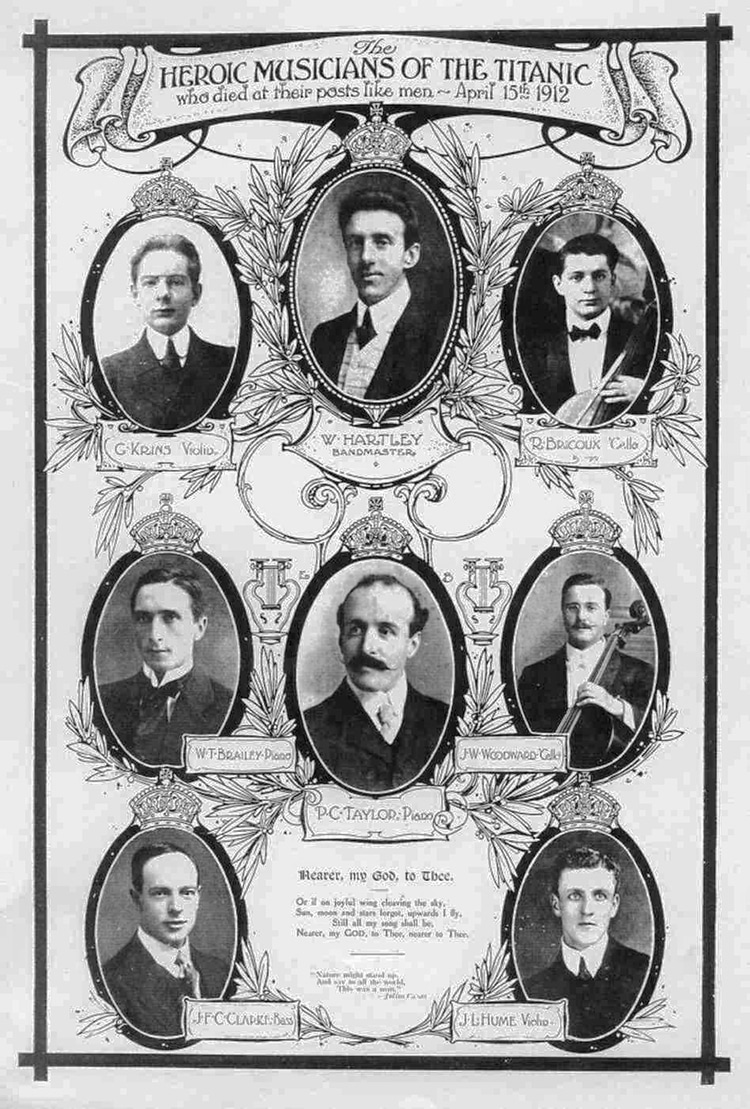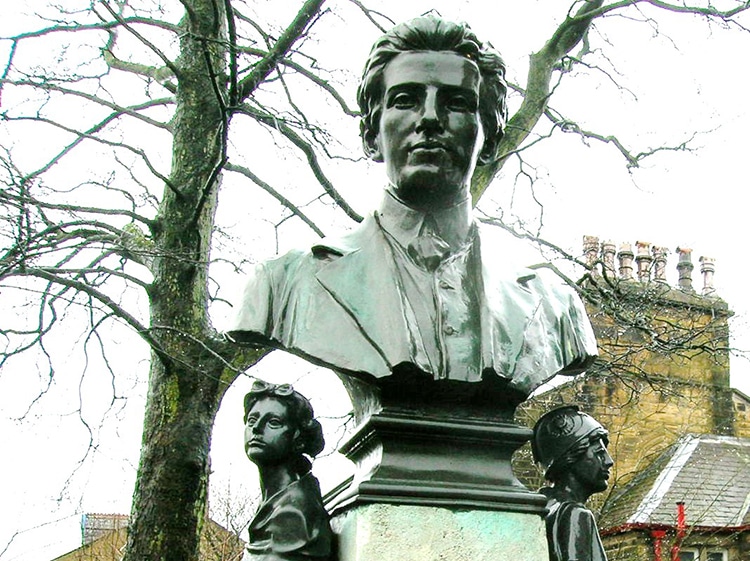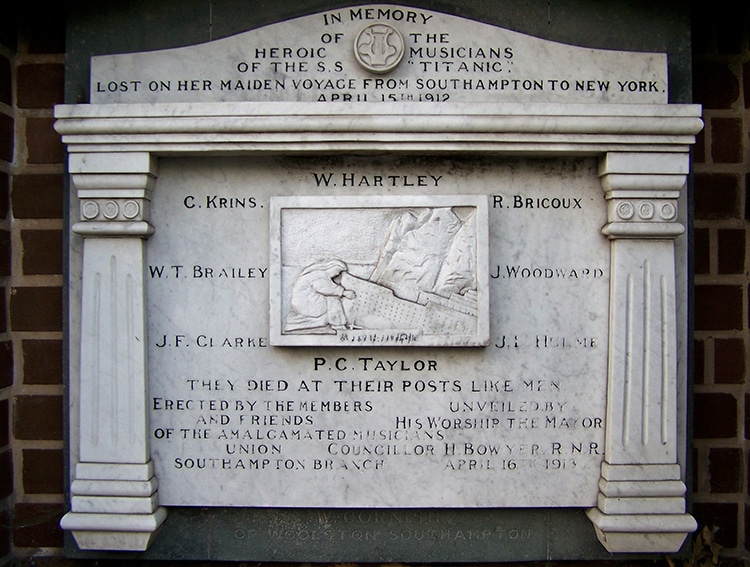
Pamphlet of the deceased band members, published by the Amalgated Musicians Union in 1912. (Photo: Wikimedia Commons, Public domain)
From James Cameron's 1997 film to the true stories of the fated ship's passengers both rich and poor, the RMS Titanic has always been associated with tragic love stories. Among the lovers separated by the sinking of the famous ship were a man named Wallace Hartley and his fiancée, Maria Robinson. While Robinson remained at home in England, Hartley set sail on the Titanic as the ship's bandmaster. Though their romance has had a tragic end, their story now lives on through the afterlife of Hartley's violin—an engagement gift from his sweetheart—which was auctioned to much fanfare in 2013.
When the young couple got engaged in 1910, Robinson gifted her fiancé with a luxurious, German-made violin. A decorative silver plaque affixed to the instrument read: “For Wallace, on the occasion of our engagement. From Maria.” In 1912, Harley took this sentimental instrument aboard the Titanic as a member of the eight-musician band engaged by the White Star Line. The band was in charge of entertaining the passengers during the brief maiden voyage across the Atlantic on a supposedly unsinkable ship.
April 14, 1912 has been remembered as the date of one of history's most famous catastrophes. Like Icarus flying too close to the sun, the Titanic fell victim (in part) to its own hubris, crashing into an iceberg that might have been avoided with better decision making. The two hours and 40 minutes which followed are perhaps one of the most widely known sequences of events in the 20th century. Passengers were urged to remain calm, there were too few lifeboats, and steerage passengers perished disproportionately as their wealthier peers were given first priority.
Famously, despited all this, the band played on. While many reports of the sinking were quickly dramatized in the press and subsequent retellings, it is widely agreed that the ship's small band under Hartley's direction was in fact instructed to play on deck. This effort to preserve calm was depicted in both the 1958 film A Night to Remember and the 1997 Titanic. Survivors giving testimony after the sinking claimed the band played the hymn “Nearer, My God, to Thee.” Others speculated it may have been a similar tune called “Autumn.” As the deck tilted and a distress flair launched, the band continued to play.
As depicted in Cameron's film, it is commonly attributed that in the final moments of Hartley's time on the ship, he told his bandmates: “Gentlemen, I bid you farewell.” All eight members died as the ship sank. Only three bodies were eventually recovered. Almost as soon as the presses began running the stories of survivors, the band's heroic calm and sense of duty began to receive attention. The musical score they selflessly provided to the disaster unfolding beneath them became a symbol of the human tragedy of the event. In fictionalized accounts, it has been used as a contrast to the entitled upper-classes who sat in lifeboats not filled to capacity and who refused to return to search for survivors.
Hartley's body was pulled from the water 10 days after the Titanic sank. Strapped to the bandleader, the rescuers found a leather valise with the initials W.H.H. Inside was his violin case and treasured instrument, as well as some musical scores. For decades, the violin was lost to public knowledge. However, upon its resurfacing in 2006, the rest of the sad story of Hartley and his fiancée has been illuminated.
Upon the violin's emergence from a musician's attic in 2006, the instrument was the subject of scrutiny by auction house Henry Aldridge & Son and Christian Tennyson-Ekeberg, author of Nearer, Our God, to Thee: The Biography of the Titanic Bandmaster. It was discovered that in July 1912, a grieved Robinson included a telegram receipt in her diary. It read, “I would be most grateful if you could convey my heartfelt thanks to all who have made possible the return of my late fiancé's violin.” Somehow, in the process of identifying and repatriating the dead, the possessions of the late bandmaster were returned to England.
Robinson died in 1939. Either before or after her death, the violin was given to the local Salvation Army. From there, the violin and its origin story were relayed to a violin teacher. The teacher then passed it on to another woman, whose child later discovered the instrument in the attic after many decades. The reappearance of such an important artifact of Titanic history was monumental, but the violin had to first be authenticated. Through tests of saltwater deposits, internal scans, and tests of the silver plaque, it was verified to be the violin Robinson presented to Hartley almost 100 years before.

The great promenade deck of the RMS Titanic. (Photo: Library of Congress Prints and Photographs Division)
In 2013, the violin was put up for auction. The violin's incredible significance to the Titanic‘s history and miasma of mythology made for high expectations. Its remarkable preservation may in part be due to the protective leather case and valise—which likely floated alongside a life-jacket-wearing Hartley. Andrew Aldridge, of the auction house, commented, “I can honestly say I don’t think any other article has made people show as much emotion as this one.”
While other Titanic artifacts have fetched large prices at auction, the violin set a new record. The relic sold for approximately $1.6 million to an anonymous buyer. Before its sale, it was also exhibited to the public in Belfast and other locations. The violin's reappearance—almost a century after its creation—once more shone a light on the tragic bravery of the Titanic‘s band. They must have known they would not make it on the lifeboats, as those steadily filled with almost exclusively the first-class passengers.

The Wallace Hartley Memorial in Colne. (Photo: Wikimedia Commons, Public domain)
Hartley was discovered having taken his precious violin, a gift from his fiancée, with him in his last moments. The band leader was quickly immortalized at home in Colne, Lancashire. His funeral in May 1912 was attended by thousands. A monument with a bust was erected in the town. All the musicians received a monument in dedication at Southhampton. It reads, “They died at their posts like men.”
To learn more about Hartley and Robinson, several books are available. Nearer, Our God, to Thee: The Biography of the Titanic Bandmaster by Christian G. Tennyson-Ekeberg addresses Hartley's life. And the Band Played On…: The Titanic Violinist and the Glovemaker: A True Story of Love, Loss and Betrayal covers the life of bandmate Jock Hume, who was only 21. And The Band that Played On: The Extraordinary Story of the 8 Musicians Who Went Down with the Titanic tells the story of the entire tragic band.
As horrific as the sinking of the Titanic was, the stories of love and bravery which emerged in the aftermath are often told alongside the tragedy—a reminder that a historic disaster had a very human side.

The RMS Titanic Musicians' Memorial in Southampton. (Photo: Marek.69 via Wikimedia Commons, CC BY-SA 3.0)
Related Articles:
Exact Replica of the Titanic Will Set Sail in 2018
Medieval Italian Village Sunken in Lake Will Resurface for the First Time in 27 Years
Monumental Building Honors Titanic’s 100-Year Anniversary
17th-Century Warship Pulled From Icy Baltic Sea Is Almost Perfectly Preserved






















































































